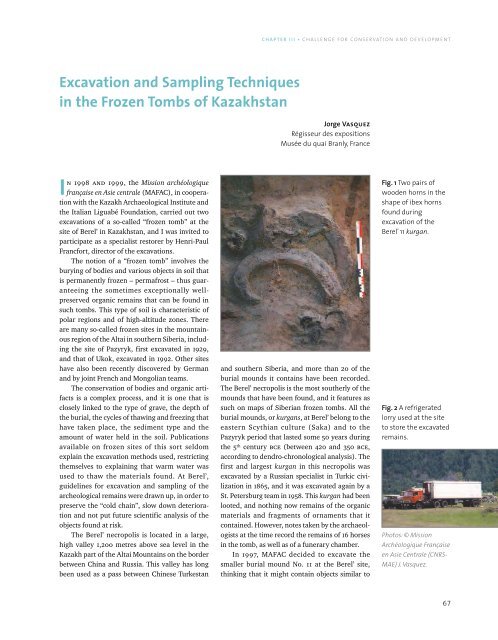Scythian Culture - Preservation of The Frozen Tombs of The Altai Mountains (UNESCO)
You also want an ePaper? Increase the reach of your titles
YUMPU automatically turns print PDFs into web optimized ePapers that Google loves.
CHAPTER III • CHALLENGE FOR CONSERVATION AND DEVELOPMENT<br />
Excavation and Sampling Techniques<br />
in the <strong>Frozen</strong> <strong>Tombs</strong> <strong>of</strong> Kazakhstan<br />
Jorge Vasquez<br />
Régisseur des expositions<br />
Musée du quai Branly, France<br />
In 1998 and 1999, the Mission archéologique<br />
française en Asie centrale (MAFAC), in cooperation<br />
with the Kazakh Archaeological Institute and<br />
the Italian Liguabé Foundation, carried out two<br />
excavations <strong>of</strong> a so-called “frozen tomb” at the<br />
site <strong>of</strong> Berel’ in Kazakhstan, and I was invited to<br />
participate as a specialist restorer by Henri-Paul<br />
Francfort, director <strong>of</strong> the excavations.<br />
<strong>The</strong> notion <strong>of</strong> a “frozen tomb” involves the<br />
burying <strong>of</strong> bodies and various objects in soil that<br />
is permanently frozen – permafrost – thus guaranteeing<br />
the sometimes exceptionally wellpreserved<br />
organic remains that can be found in<br />
such tombs. This type <strong>of</strong> soil is characteristic <strong>of</strong><br />
polar regions and <strong>of</strong> high-altitude zones. <strong>The</strong>re<br />
are many so-called frozen sites in the mountainous<br />
region <strong>of</strong> the <strong>Altai</strong> in southern Siberia, including<br />
the site <strong>of</strong> Pazyryk, first excavated in 1929,<br />
and that <strong>of</strong> Ukok, excavated in 1992. Other sites<br />
have also been recently discovered by German<br />
and by joint French and Mongolian teams.<br />
<strong>The</strong> conservation <strong>of</strong> bodies and organic artifacts<br />
is a complex process, and it is one that is<br />
closely linked to the type <strong>of</strong> grave, the depth <strong>of</strong><br />
the burial, the cycles <strong>of</strong> thawing and freezing that<br />
have taken place, the sediment type and the<br />
amount <strong>of</strong> water held in the soil. Publications<br />
available on frozen sites <strong>of</strong> this sort seldom<br />
explain the excavation methods used, restricting<br />
themselves to explaining that warm water was<br />
used to thaw the materials found. At Berel’,<br />
guidelines for excavation and sampling <strong>of</strong> the<br />
archeological remains were drawn up, in order to<br />
preserve the “cold chain”, slow down deterioration<br />
and not put future scientific analysis <strong>of</strong> the<br />
objects found at risk.<br />
<strong>The</strong> Berel’ necropolis is located in a large,<br />
high valley 1,200 metres above sea level in the<br />
Kazakh part <strong>of</strong> the <strong>Altai</strong> <strong>Mountains</strong> on the border<br />
between China and Russia. This valley has long<br />
been used as a pass between Chinese Turkestan<br />
and southern Siberia, and more than 20 <strong>of</strong> the<br />
burial mounds it contains have been recorded.<br />
<strong>The</strong> Berel’ necropolis is the most southerly <strong>of</strong> the<br />
mounds that have been found, and it features as<br />
such on maps <strong>of</strong> Siberian frozen tombs. All the<br />
burial mounds, or kurgans, at Berel’ belong to the<br />
eastern <strong>Scythian</strong> culture (Saka) and to the<br />
Pazyryk period that lasted some 50 years during<br />
the 5 th century bce (between 420 and 350 bce,<br />
according to dendro-chronological analysis). <strong>The</strong><br />
first and largest kurgan in this necropolis was<br />
excavated by a Russian specialist in Turkic civilization<br />
in 1865, and it was excavated again by a<br />
St. Petersburg team in 1958. This kurgan had been<br />
looted, and nothing now remains <strong>of</strong> the organic<br />
materials and fragments <strong>of</strong> ornaments that it<br />
contained. However, notes taken by the archaeologists<br />
at the time record the remains <strong>of</strong> 16 horses<br />
in the tomb, as well as <strong>of</strong> a funerary chamber.<br />
In 1997, MAFAC decided to excavate the<br />
smaller burial mound No. 11 at the Berel’ site,<br />
thinking that it might contain objects similar to<br />
Fig. 1 Two pairs <strong>of</strong><br />
wooden horns in the<br />
shape <strong>of</strong> ibex horns<br />
found during<br />
excavation <strong>of</strong> the<br />
Berel’ 11 kurgan.<br />
Fig. 2 A refrigerated<br />
lorry used at the site<br />
to store the excavated<br />
remains.<br />
Photos: © Mission<br />
Archéologique Française<br />
en Asie Centrale (CNRS-<br />
MAE) J. Vasquez.<br />
67
















